Maya Hey works across disciplines as a researcher, foodmaker, and educator with backgrounds in the culinary arts, food science, and community building. As a Vanier Scholar (SSHRC), Maya is pursuing her doctorate in Communication Studies at Concordia. She studies fermentation and uses feminist theories to better understand discriminating tastes and practices. With more than 10 years of experience facilitating discussions around contemporary food issues, Maya has developed an array of collaborative projects with academic and lay audiences.
Blog post
Work-life balance: 10 tips to make it happen
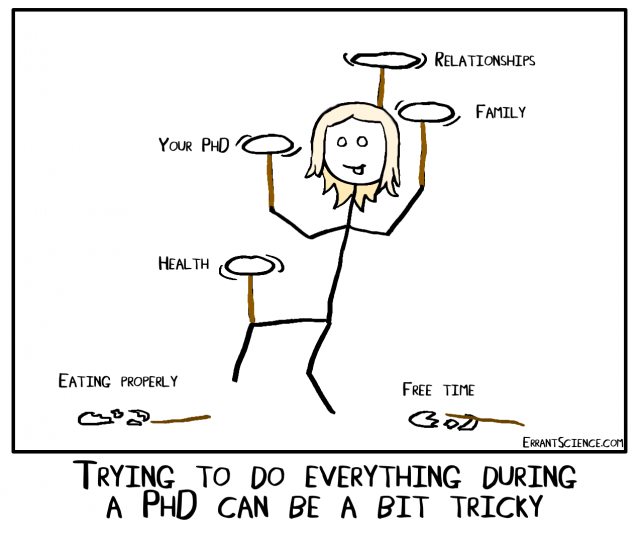 Image use courtesy of Errant Science. | Photo: Errant Science
Image use courtesy of Errant Science. | Photo: Errant Science
September can signal the start of many things. We buy new planners. We plan meals so that lunches are packed with fresh produce. We promise ourselves that this year will be different. And then, around late October, things start to fall apart. By November, we’re all wishing for our personal Tim Gunn from Project Runway or a Fab Five member to pep talk us into making it all work. Weather notwithstanding, things get heavy and we long for the interlude of December: “Are we there yet?”
While the semester is still at a fresh start, I reflected on some key tactics for time management, stress management, and work-life balance in general. I wanted to share some practical tips as others have shared their insights with me. This list is by no means comprehensive, but my hopes are that some might help you navigate the term ahead.
Managing Time
Prioritize your tasks with a focus grid. A focus grid is a way to organize your tasks according to the following four categories: urgent and important, not urgent but important, urgent but not important, and neither urgent nor important. It is much easier to visualize:
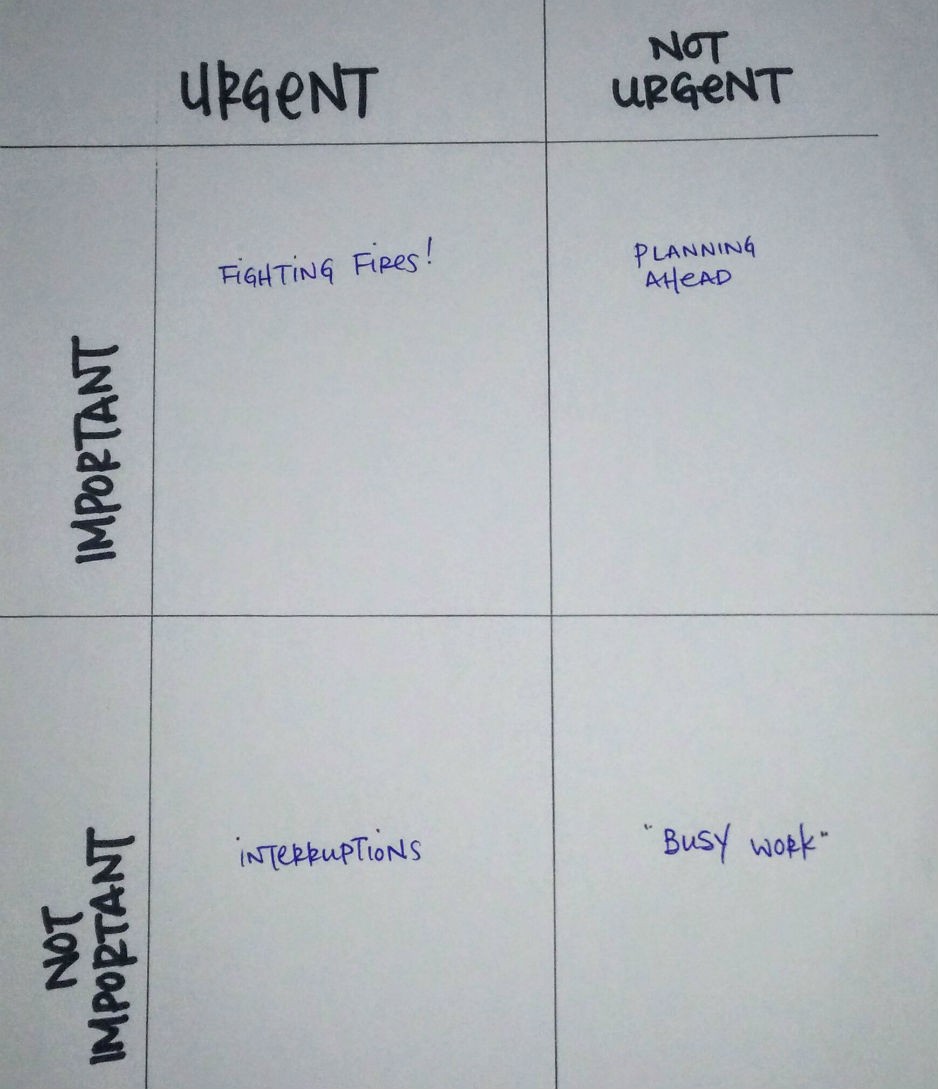 Time-management matrix first theorized by Stephen Covey. | Photo: Maya Hey
Time-management matrix first theorized by Stephen Covey. | Photo: Maya Hey
Like the example of putting out metaphorical fires, urgent and important things should be top priority! According to Stephen Covey, the trick is getting to the “not urgent but important” items before they become urgent, so that the order of tackling tasks becomes:
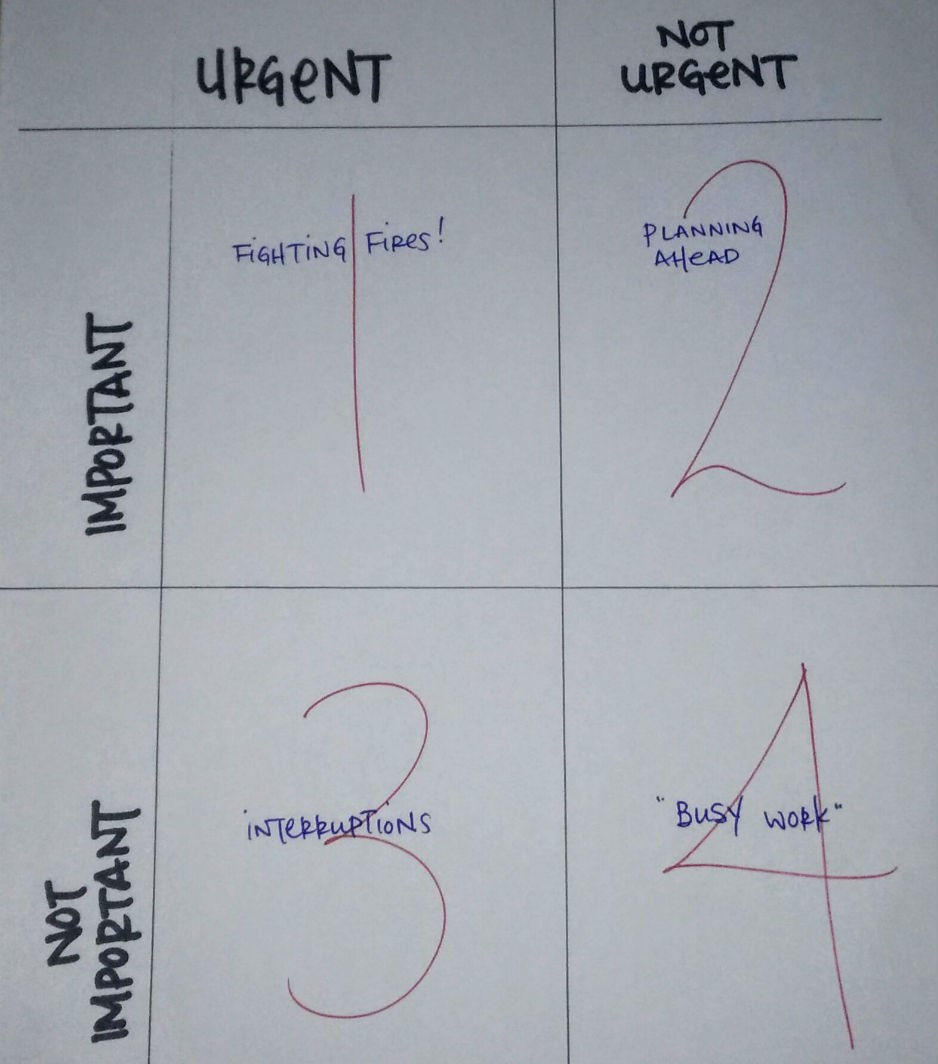 The ideal order of operations. | Photo: Maya Hey
The ideal order of operations. | Photo: Maya Hey
This grid becomes my lifesaver when I am particularly overwhelmed. When the sheer number of tasks deflates my enthusiasm, I triage my tasks by urgency and importance in order to determine what really needs to get done.
Follow the 1-3-5 guide. Another way to organize tasks is by goals for the day, that is one big task, thre medium tasks, and five small tasks. I first heard about this through the WeWork communal offices in London, where sheets were printed out and made available to members for everyday use.
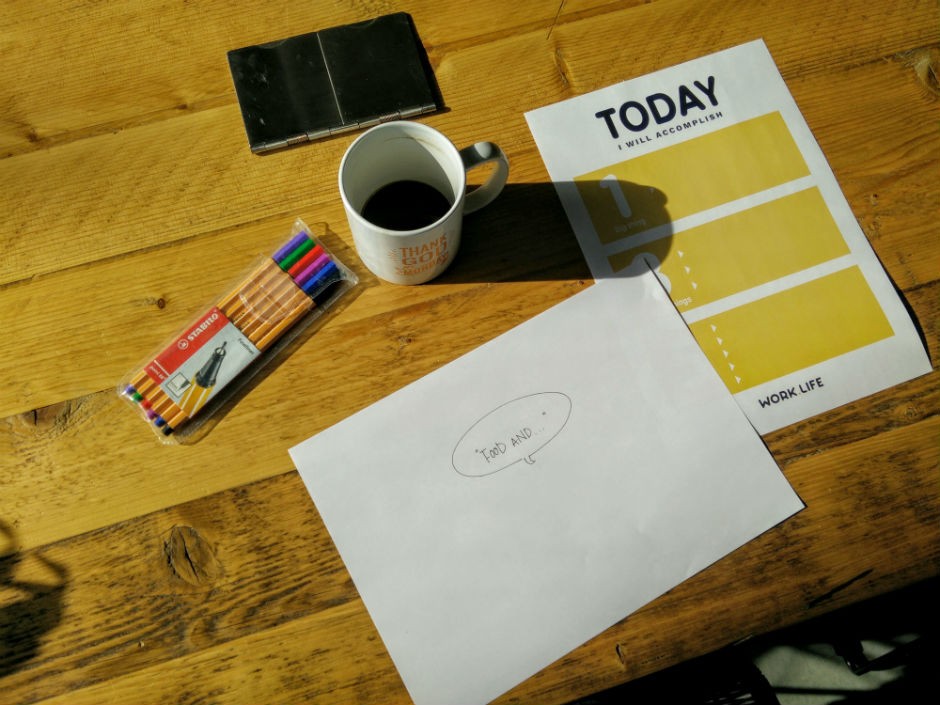 Organizing tasks day by day. | Photo: Maya Hey
Organizing tasks day by day. | Photo: Maya Hey
I use this to structure days that do not otherwise have structure (as in, days working from home). Since the 1-3-5 guide relies on quantifiable goals, I enjoy the sense of self-actualization that comes with tending to the big things and the small stuff all in the same day.
Find a notation / notification system that works for you. Since I started grad school, I’ve been relying on Evernote because I can take notes and setup alarms using the same interface. For example, if I see a Call For Papers (CFP), I’ll copy and paste the details into a new note and setup an alarm two weeks before the due date. I also installed the Evernote Chrome plug-in so that I can capture a website and send it to a notebook in my Evernote account without having to interrupt my (sometimes maniacal) internet searches.
Google Suite and Apple Reminders offer something similar, but I prefer Evernote because: 1) their desktop version allows me to work on documents offline without having to download files in advance, 2) their tagging system makes files easier to find, and 3) the same Evernote account can be used across multiple devices. Another tip: I organize my folders, my email labels, and my Evernote notebooks using the same headings.
Concentrate in short spurts. Professor Alexis Shotwell’s YouTube series on guilt-free writing suggests working for 45 minutes with a built-in rest of 15 minutes. This breaks up a large project (like my comprehensive exams) into bite-size chunks. There are plenty of apps that can assist (Pomodoro and Forest immediately come to mind), but a simple egg-timer will do too. What matters is intention. Distractions abound, so intentionally setting aside time to work and to relax makes daunting tasks seem incremental and, ultimately, doable.
Keep emails short and sweet. I used to craft the longest emails, obsessing over each word and phrase, only to find that most folks skim through email because we are inundated with messages! I’m guilty of this too: whenever I see a long email, I mark it as ‘unread’ and leave it rotting in my inbox until I absolutely have to deal with it. Now, I try to keep emails under two paragraphs. If what I’m attempting to communicate cannot fit in two paragraphs’ length, I’ll write to arrange a meeting or phone call. Emailing this way streamlines how I professionally correspond with others: shorter messages to write from my end and shorter messages to read on the receiving end.
Managing Stress
Use different computer logins. I heard about this tactic through a colleague who recently defended her PhD and it exemplified how a minor shift can have major impact. At a time when one giant project (like a dissertation) can consume one’s all, setting up two computer logins allows for a deliberate shift from work to play or play to work. One login contains all of my research documents, readings, and ongoing projects, while the other login stores my Netflix password. To be sure, this might be discounted as an extreme case of compartmentalizing, but burnout is real, and I remember avoiding my computer at the height of my stress because it only represented work.
Use analog methods. I recommend this to my students who dread the blank screen of a word document, when the blinking cursor can feel like a nagging, tyrannical force. Sometimes I will print out a document (single-sided) to do manual cut-and-paste, literally with scissors and tape.
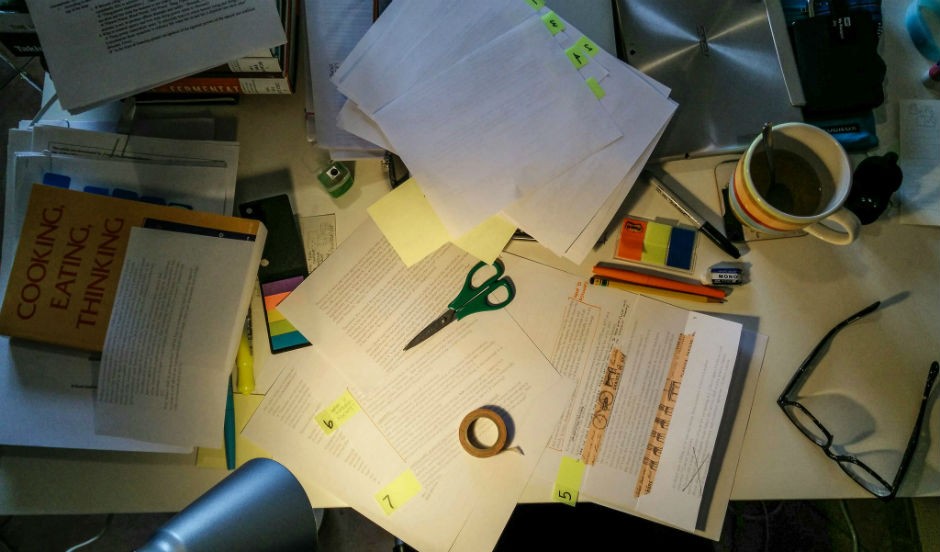 Still-life image from a writing project. | Photo: Maya Hey
Still-life image from a writing project. | Photo: Maya Hey
Or, I’ll draw out an argument in the form of a diagram on a whiteboard (or unlined paper if I’m not near a classroom). Both allow me to visualize "the big picture" in a more embodied way. Instead of a mental paralysis, I like to move things around, including myself.
Honour all attempts. I used to joke about "academic callouses" that develop over the course of all the rejections that one encounters in the academy. Rather than dismiss these rejections with an “oh well” sentiment, I wanted to celebrate all of my efforts at putting together dossiers and applications, regardless of their outcomes. To help me visualize these attempts, I used to write out a project or submission on a clothes pin, one pin per project. Then, I’d move that clothes pin along a string to chart its progress: upcoming deadline, submission filed, response pending, response received. By keeping the progress in value-neutral terms, the pins represented all of my efforts instead of the outcomes only.
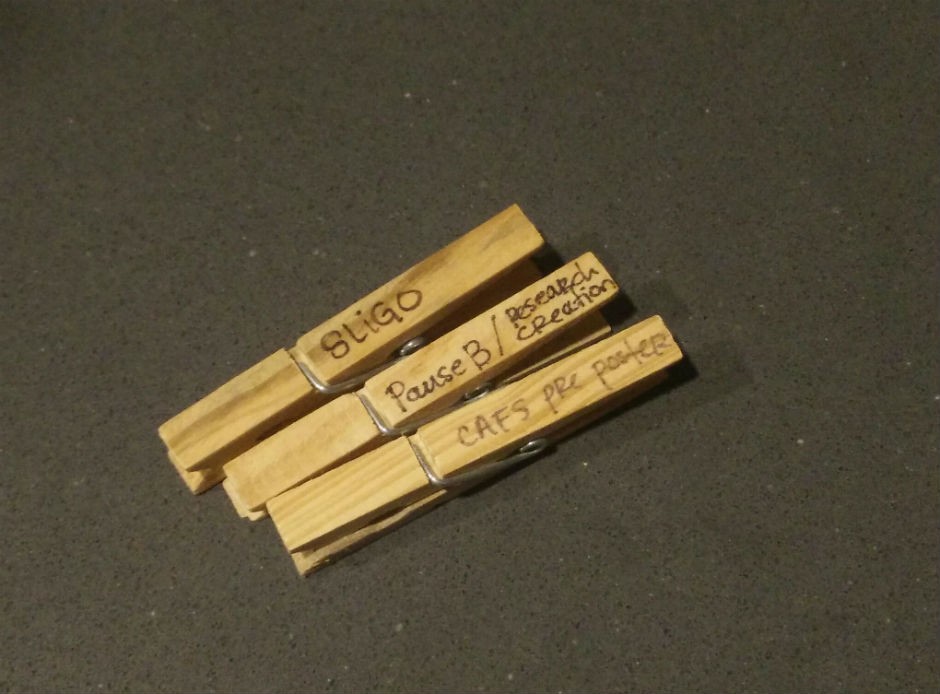 Materials to help visualize progress. | Photo: Maya Hey
Materials to help visualize progress. | Photo: Maya Hey
Honouring all of my attempts kept me from selectively valuing the externally recognized, outcome based successes and helped me acknowledge my own work in a more process-based manner.
Find a neutral person to talk things out. Speaking of neutral … I found it helpful to talk through stressful times with someone who can afford to call me out. This might be a therapist or a life mentor or someone from a previous life chapter. What matters is that my relationship with this person is not at risk when I share information with them. Granted, friends and colleagues (even supervisors) can be valuable resources, but I find myself self-censoring and continued censorship adds another layer of stress for me. By talking things out with a neutral person, I can speak freely without having to think of the social stakes at hand. And, more often than not, this neutral confidant provides some much-needed perspective that helps me better understand myself.
“If you’re not having fun, you’re not doing it right.” A manager shared this with me when I worked at Trader Joe’s, and I carry this reminder with me into other aspects of my life. Humour and humility are key to balancing out the intensity of hard work. When the seriousness of work weighs me down, I find momentum in small delights.
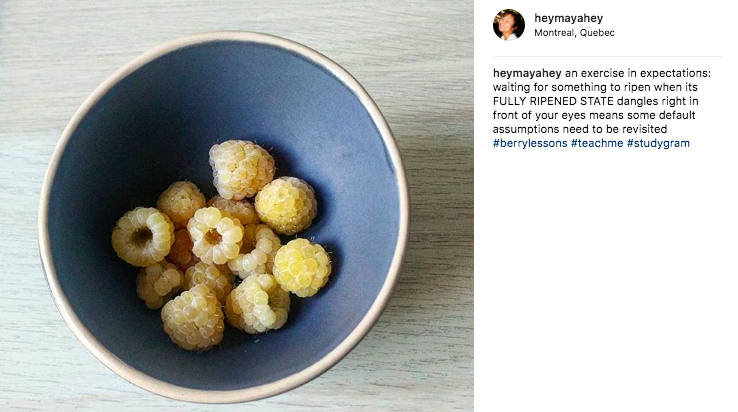 Curbing expectations, one bite at a time. | Photo: Maya Hey
Curbing expectations, one bite at a time. | Photo: Maya Hey
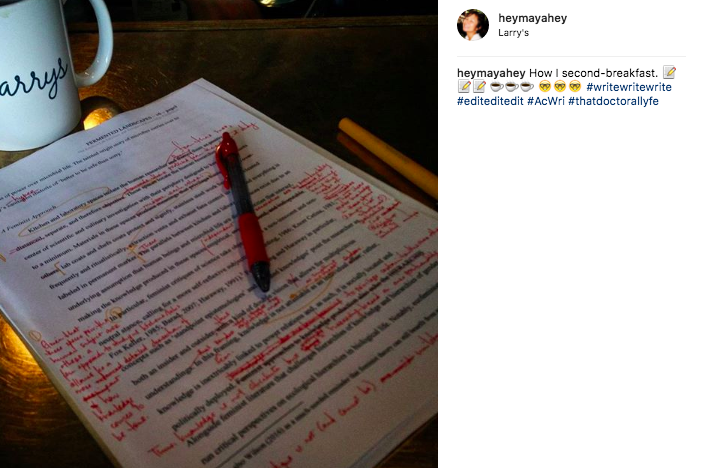 Humour through hashtags like #thatdoctorallyfe | Photo: Maya Hey
Humour through hashtags like #thatdoctorallyfe | Photo: Maya Hey
Laughter can acutely cut through a tense moment but so can an ambience of lightheartedness. I choose to make light of my own assumptions because they give me a sense of ownership over my own faults. It’s like airing out my wrongs so that I can move on from them.
“High Tide Lifts All Boats”
I’ve been fortunate that others have shared their insights with me. Especially in competitive climates where individual merit is placed above collective benefit, I’m reminded of a phrase that a friend once shared with me: “high tide lifts all boats.” Instead of focusing on the success of a single boat, how can we share "insider" know-how (such as when the tide comes in)?
Work-life balance entails segmenting out the work world and the life world, so that one can structure and organize each. But it also entails recognizing that — no matter how separate — these worlds are integrated because the same person moves through them. It means that we are not machines who merely execute tasks. Work-life balance reminds us that we need to perpetually expand our toolbox for combatting isolation and sluggishness. We need to look out for each other.
It is in this spirit of sharing tactics that I wanted to call upon you, dear reader. Admittedly, what has worked for me may not work for others, but perhaps we can collectively get a conversation going while the academic term is still fresh. Join me on Twitter (@heymayahey) using the handle #WorkLifeBalance and share your own tactics.
About the author


